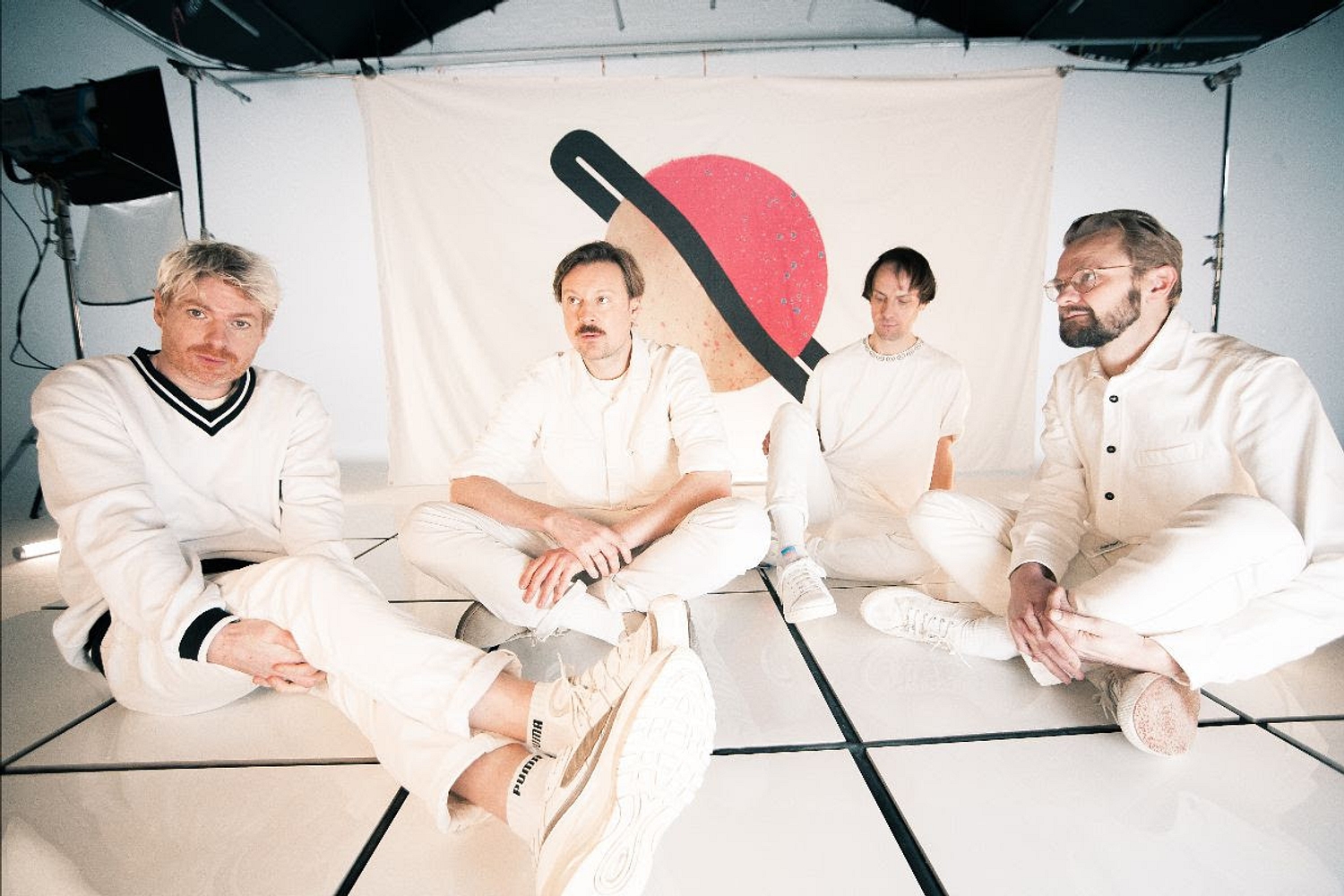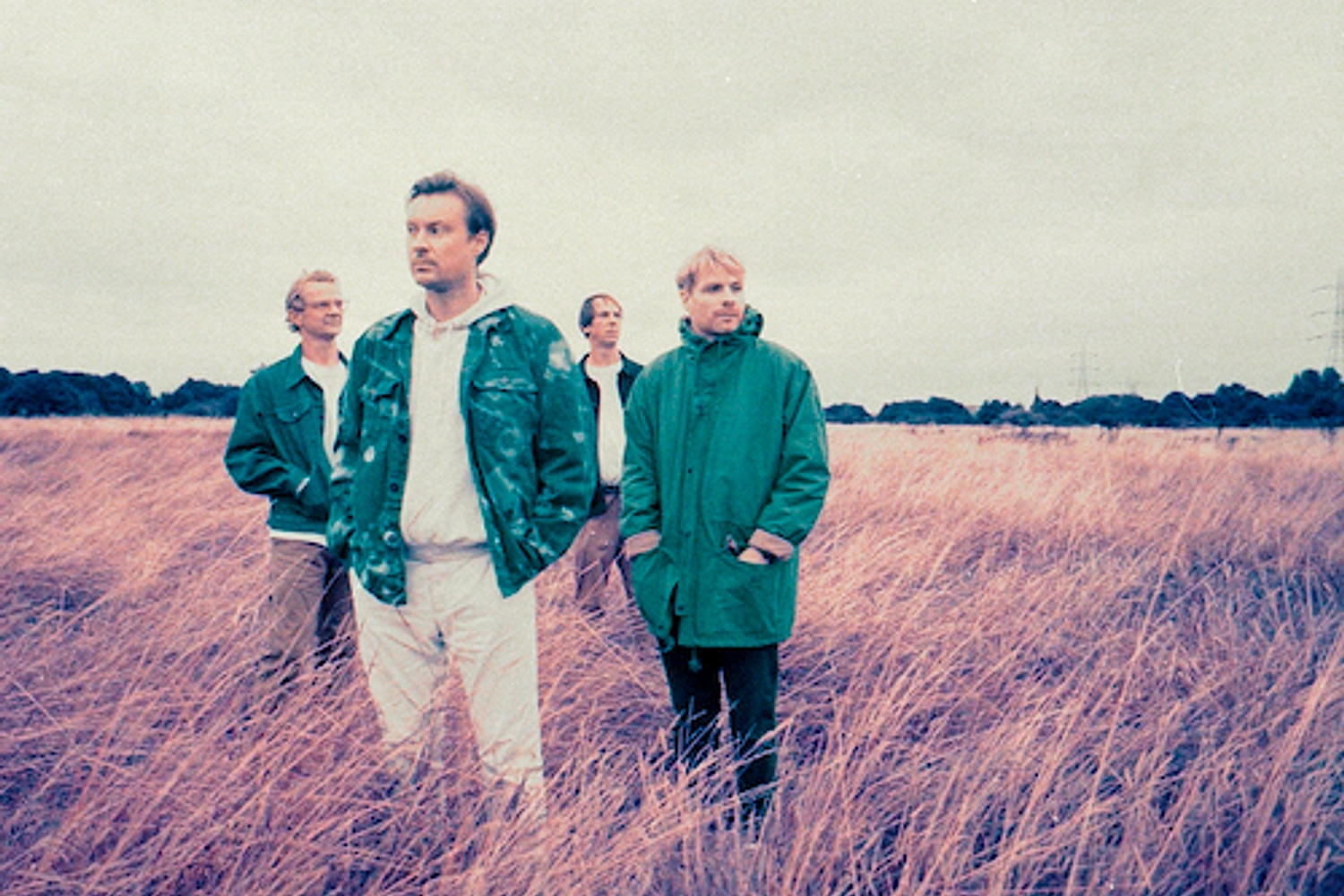Interview Django Django: ‘I See Tracks As Colours’
Aurora Mitchell talks to Dave Maclean about the origins of the band, psychedelia and more.
Edinburgh originated four piece Django Django make experimental pop that is hard to put in a box, perhaps because of the unlikely inspirations the band pull from. Now residing in the heart of East London, they’re set to release their debut album on January 30 shortly before heading out on a UK tour. Nevertheless, things could have shaped up very differently had they not worked away for 3 years, constructing a body of work, with only the aid of early demos, in the confines of their bedroom. Aurora Mitchell talks to Dave Maclean about the origins of the band, psychedelia and more.
Quite a long time has passed since you formed to the completion of your debut album, do you feel like the experience has been formative?
Definitely! We wanted to produce the record ourselves so we had to learn the ropes. It’s funny with the Myspace phenomenon, one of the weird things was that once you put a demo up, you were a proper band, but really we were just making songs in the bedroom and putting them up, we had no idea about playing them live or making an album! People think that was 2009 and this is 2012, where have you been? But we’ve been doing everything for the past few years, it’s been pretty hectic. Personally, I’ve learnt a lot about production, what we want to be as a band and what we’re doing. It’s just been nonstop since then.
Do you feel like there was any expectation to carry on after the first demo?
Yeah, definitely. I think there was an expectation to play live and an expectation to make more music. There was an expectation straight away for an album, which was crazy because we had two songs, no band, and no equipment. Before the internet, there were songs that wouldn’t see the light of day but because of the internet, everyone heard the initial song and everyone wanted to hear more. In a way, it just got us going. We didn’t have a label at the time so there were no demands. It had its good points and bad points but it was always about getting on with it.
‘Default’ has been around for a long time as a demo, what made you rework it to be the lead single?
It always felt like it needed stuff done to it. It just sort of sat on the back burner. We almost forgot about poor little ‘Default’ and then when we rerecorded the guitars we thought, this could be a good single to launch the album because it’s quite instant and people seemed to think it was catchy, so it just came back from the dead. It’s doing what we hoped, it’s instant and accessible. We’re quite glad that we did that.
‘Waveforms’ is quite texturally complicated, like water, was that meant to be the effect?
It’s got that kind of underwater vibe. It was done with a colour palette in mind; it was all purples and blues. The video has an underwater feel and drawing lines between waveforms as if music is actually waves in the ocean, and out of all the songs, it’s the one that had a sort of colour palette to it that we really liked. It was quite different switching to ‘Default’ which is a lot more splattered in texture and colour, it’s a bit more poppy. I think we do that a lot, switching between snappy and upbeat and trippier and growers like ‘Waveforms’, which is exactly that.
So was the songwriting process for ‘Waveforms’ like synaesthesia?
It’s something that we talk about quite a lot. When we’re producing, I see tracks as colours, whether that be a rainbow or a blue colour. I think a lot of music should have that, it’s a strange thing but there’s something in it, there’s some phenomenon there that makes people hear colours. I think the album has colours. When I hear the album, it goes from sandy to metallic blues like waveforms, and I think that was something important about the album, to have that range of colours and textures.
What was the recording process like?
Completely chaotic. It was generally me sitting in my dressing gown in the flat, getting up, switching on the computer and drinking coffee and making sense of whatever we’d recorded the night before. It was quite free because we didn’t have people or a label breathing down our neck, telling us to get on with it or change it. We took our time and had fun with it and experimented and never found any pressure for deadlines. I don’t think we’ll have that again because we’d be 50 by the time we’d be on album three! It was definitely free and experimental, trying to push what we have to the limits, with a crappy computer and one mic to make an album. I was broke and I was a student at Chelsea at the time, I was working at the pub, and I didn’t have a load of money or a load of time, but that shaped the album so I wouldn’t change it. I think we’ll do things differently now that we have a studio and we have a bit more klout behind us with the label. Things will be easier but not a lot will be different because we enjoy the way we work. It was kinda us in a bubble mucking around.
What inspirations are behind the album?
We’ve got quite weird inspirations. Personally, my inspiration is not what a lot of people would really expect. A lot of reggae music and dancehall and then pop producers to The Beatles and a lot of blues and surf guitar like Link Wray. My inspiration comes from what sounds people are into. I think people perhaps find it odd that I’m really into raga and acid house. I’m not just into 60s psychedelia but it all ends up in the pot. Our record collections are pretty bizarre. A lot of art and painters also, because when it comes to texture and colour, things like visual arts and cinema help you get there, even Monty Python is in there. It’s just a lifetime of being into stuff, of being excited by things. We didn’t really think about it at the time, but now if we sat down and had to pinpoint the things that changed us or got us really excited, it’d be quite hard.
The album artwork is quite psychedelic, how did you choose it?
It was a collage I made myself. Psychedelic is a weird one because when I make these collages I don’t really see them as psychedelic, I just think of it as a collage that represents sounds. We get the psychedelic thing a lot and I can see why but we’re not really the kind of guys sitting around and taking drugs, we’re more into ideas. At the end of the day, that’s what psychedelia is, a different way of seeing things. It’s mind expansion. Dreams are psychedelia, thoughts are psychedelia. Your brain makes sense of chaos and you try to put things together but they turn out a bit upside down but it’s really embracing oddness and different ideas.
How did you manage to bring your music to a live format?
We started off really stripped back. We just started with a drum machine and I’d play a bit of drums. It’s been a journey of trial and error, to be honest. I think we’re still trying things and we’re not afraid to try things and have them not work. We just go with an idea and try it for a few days but if it doesn’t work we’ll just scrap it and move on. We’re not that fussed about making it similar to the recording because it’s difficult to recreate a studio album live, especially one like this with so much layering. I can’t even remember all the instruments that are on the album because a lot of it was just sounds in the bedroom. We just gradually add things; we’re still in the process of trying to make the album work live so we’ll see what happens really.
Django Django’s self titled debut album is released via on 30th January 2012.
Read More

Django Django release new video for album track ‘Slipstream’
They’ve also announced plans for a UK and European tour this autumn.
10th July 2023, 1:30pm

Django Django share new single ‘Don’t Touch That Dial’
The second part of their four-part album ‘Off Planet’ is out now.
17th March 2023, 12:00am

Django Django announce new four-part album ‘Off Planet’
They’ve teamed up with Self Esteem for new single ‘Complete Me’.
8th February 2023, 12:00am

Django Django announce ‘Glowing In The Dark’ deluxe edition
Featuring five new songs!
26th August 2021, 12:00am
With Bob Vylan, St Vincent, girl in red, Lizzy McAlpine and more.

